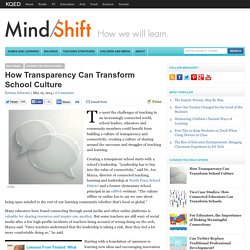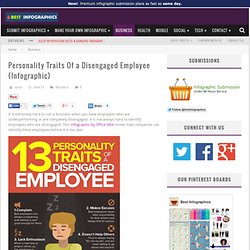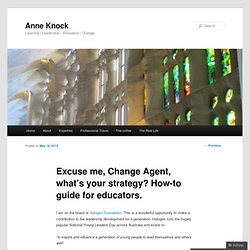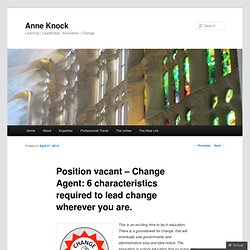

The Key to School Change: Getting Comfortable With Discomfort. It is an accepted principle of organizational change: Change is hard.

We are told that the process of change includes stages of recognition, denial, grief, and eventual progress, much like the steps we undergo to overcome loss or addiction. I disagree. One of the central findings of my work with well over 100 schools in the last several years is that, relative to the really hard obstacles and events in life that we all face, changing most school organizations is not hard -- it is uncomfortable. How Transparency Can Transform School Culture. Getty To meet the challenges of teaching in an increasingly connected world, school leaders, educators and community members could benefit from building a culture of transparency and connectivity, creating a culture of sharing around the successes and struggles of teaching and learning.

Creating a transparent school starts with a school’s leadership. “Leadership has to buy into the value of connectivity,” said Dr. Joe Mazza, director of connected teaching, learning and leadership at North Penn School District and a former elementary school principal in an edWeb webinar. “The culture offline or online has to say we care about being open minded to the rest of our learning community whether that’s local or global.” Many educators have found connecting through social media and other online platforms is valuable for sharing resources and inspire one another. Connecting with other educators puts control in the hands of educators, but it also helps push the field forward.
Related. Personality Traits Of a Disengaged Employee. It is extremely hard to run a business when you have employees who are underperforming or are completely disengaged.

It is not always hard to identify employees who are disengaged. This infographic by Office Vibe shows how companies can identify these employees before it is too late: Submit your own infographics People who visited this article also visited: Excuse me, Change Agent, what’s your strategy? How-to guide for educators. I am on the board of Halogen Foundation.

This is a wonderful opportunity to make a contribution to the leadership development for a generation. Halogen runs the hugely popular National Young Leaders Day across Australia and exists to: “to inspire and influence a generation of young people to lead themselves and others well” I really enjoy the board meetings and they are also a great learning experience for me, as we collaboratively develop strategy to guide the future direction of the organisation. Working with the fellow board members and the CEO we focus on the big picture. Position vacant – Change Agent: 6 characteristics required to lead change wherever you are. This is an exciting time to be in education.

There is a groundswell for change, that will eventually see governments and administrators stop and take notice. The innovation in school education that so many of us seek seems to be low on their policy agenda at the moment. So as a result leaders are emerging, individuals, groups and entire schools, are taking action and creating a movement. The time for incremental, slow-moving change has passed, and now we need to step it up a pace. PASSION...PURPOSE...PRIDE: Leaders Are Agents of Change. If there is one thing I have learned in my twenty plus years as an educator it is this - The best leaders are able to influence us in positive ways regardless of how long we have been in education.

And there lies the beauty in what we do. Admittedly, most of what I believe in, model my ideas from, and emulate who I aspire to be like has been profoundly impacted by people I genuinely admire and respect. They are my "influencers. " They are people just like you and me who have shaped my fundamental belief system in what it means to be a teacher. Whether I have known them for years, months, or only days, the power of time and knowledge doesn't discriminate.
For those of you who may not know, I am currently working on my Ed.S. with thoughts of someday leading a district as Superintendent. Because along the way comes someone who influences you in a way that makes you pause and reflect and ask, “what if?” Wow, I thought to myself. Here are 6 things I learned from Dr. 1. 2.
Change Agents are Leaders: The four transitions toward culture change in your school. Change, culture and leadership are concepts that are inseparable.

Achieving the desired culture for your team or school requires a process of change, and leadership is essential to make this happen. In my last post I encouraged you to consider leading change and taking on the role of a change agent wherever you are in your school, organisation, or even your family. What makes you a leader is that there is an idea or a vision for the future that you cannot shake, and you are compelled to do something about it. This idea will make life better for someone and your mantra needs to be “if not me, then who?” How do you eat an elephant? Transitions are the phases we work through on the way to changing culture. As I have thought about this, played around with ideas and read about culture change, I have identified four transitions to change culture. 1.